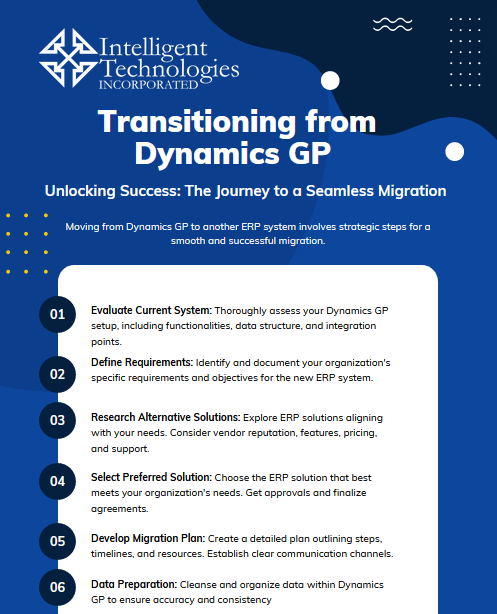Wondering what to do next after Microsoft’s announcement on the sunsetting of Dynamics GP is like nearing the end of a gripping mystery novel. You’re eager to know what comes next but apprehensive about the unknown, left guessing how it will affect your day-to-day operations.
Much like tying together plot threads, architecting a smooth transition requires strategic planning: preparation, execution, and a deep understanding of your GP system. This detailed guide is your roadmap, packed with practical advice on GP end-of-life upgrade strategies. It deciphers the intricate process, breaking it down into manageable segments. Think of it as understanding the author’s intent, translating it into a language you understand.
No cliffhangers here, only practical steps to steer your upgrade strategy – a story of successful adaptation and thoughtful execution. Ready to turn the page?
Comprehensive Guide to Microsoft Dynamics GP End of Life Upgrade Strategies
- Understand the need and importance of an upgrade for Dynamics GP.
- Get an overview of what to expect in the ensuing upgrade process.
An Overview of Upgrading Microsoft Dynamics GP
Upgrading your Microsoft Dynamics GP software is more than just a technology update. It involves a holistic view of your entire business operation, understanding where it stands today, and establishing where you want it to be in the future. Upgrades are integral to ensuring your business continues to operate at its best. Dynamics GP upgrades come with potential benefits like increased efficiency, additional functionality, improved security, and better support that are worth considering.
The upgrade process involves planning, preparation, testing, and implementation. Every stage requires the involvement of different teams in your organization, from IT staff, software vendors, to end users. That means clear communication, careful planning, and managed expectations are critical.
Dynamics GP Upgrade End of Life Upgrade Strategies
Preparing a strategy to move through your upgrade is like creating a roadmap for a long journey. A carefully crafted strategy will help mitigate risks, minimize business interruption, and set the course for your upgrade success.
The Importance of Transitioning Before It’s Too Late
The decision to transition to a new ERP system is not one to be taken lightly. However, the announcement of the sunsetting timeline underscores the need for existing Dynamics GP users to consider their options sooner rather than later.
The timeline shows that while existing Dynamics GP users will maintain the ability to purchase new licenses and modules beyond the 2026 cut-off date, there will be no more major feature updates. This raises critical questions about the platform’s long-term viability and its ability to keep pace with technological advancements.
The cessation of new customer sales for Dynamics GP subscription and perpetual licensing sales by 2025 signals a shift in Microsoft’s focus towards newer, cloud-based ERP solutions. This shift highlights the importance of evaluating alternative options that can better align with your business’s changing needs and technological landscape.
While Dynamics GP has served many businesses faithfully over the years, now is the time to assess whether it remains the best platform for your organization’s future success.
Deciding to Upgrade
Ultimately, the decision to upgrade your GP system hinges on several factors – business needs, operational efficiency, financial implications, and tech trends. While upgrades may seem daunting, with the right plan and approach, they can deliver strong benefits to your business.
Remember that keeping your business software up to date is crucial in today’s rapidly developing digital economy. So don’t wait until it’s too late. Plan your upgrade to ensure your business stays ahead of the curve.
This glimpse of what upgrading Dynamics GP entails is certainly not exhaustive, but it should provide some context and backdrop for understanding the importance of timely upgrades. Let’s march on with the Dynamics GP upgrade journey further.
Step-by-Step Guide to Microsoft Dynamics GP Upgrade
- Understand the rationale behind the upgrade.
- Strategic planning for seamless execution.
- Key insights to tackle potential challenges during an upgrade.
Step 1: Understanding the Need for Upgrade
Understanding GP End of Life
As the concept of GP’s end of life denotes the termination of support and updates from Microsoft, one might wonder – why is it essential for businesses to understand this? If you wait until support and security patches are no longer available to plan your next move, your Dynamics GP system becomes susceptible to cybersecurity threats, potentially jeopardizing sensitive business data. It also has the potential to affect your financial performance. Downtime, revenue losses, remediation expenses, and legal fees can all have significant and lasting consequences for your business. According to a 2022 report by IBM, the average cost of a data breach reached an astonishing $4.35 million dollars.
Risks Associated With Not Upgrading
Not going ahead with a GP upgrade could pose severe risks, like these:
- Compatibility Issues: Unsupported software may not be compatible with newer technologies, leading to performance issues, system crashes, and compatibility problems with other software applications.
- Limited Functionality: Unsupported software misses out on critical updates, bug fixes, and feature enhancements, limiting your ability to leverage new functionalities, improve efficiency, and stay competitive in the market.
- Disrupted Business Operations: Security breaches, performance issues, and compatibility problems can disrupt business operations, hinder productivity, and result in costly downtime.
- Compliance Risks: Using unsupported software may lead to non-compliance with industry regulations and standards, exposing your business to legal and financial risks.
Without regular updates and support, businesses could face software performance issues and a drastic decrease in efficiency.
Step 2: Planning Your Upgrade
Importance of a Well-Planned Upgrade Strategy
An unplanned GP upgrade can cause significant disruptions to a business. With a well-structured upgrade plan, businesses can minimize downtime, ensure operational continuity, and ensure a gradual transition for employees. A coherent plan serves as a roadmap, outlining the steps to follow, creating clarity and accountability among team members.
Key Considerations in Planning
When planning for an upgrade, several factors need consideration. These include evaluating current GP usage, establishing the business’s needs, and assessing the company’s technical preparedness for the upgrade. Assessing these elements will help in avoiding unnecessary costs and disruptions.
Step 3: Executing the Upgrade
Detailed Process of Executing the Upgrade
Executing a GP upgrade involves multiple stages. It starts with preparing the existing data for migration, installing the new version, migrating the data, and finally, thoroughly testing the new system. Clear communication at every stage is vital for a seamless transition.
For a visual breakdown of the steps involved, look at our infographic, “Transitioning from Dynamics GP to another ERP”. Below is a preview.

Potential Challenges and How to Overcome Them
Even with meticulous planning, GP upgrades can face several challenges, such as data migration issues, technical glitches, or user resistance. Having a comprehensive troubleshooting guide and providing intensive training to the users can help mitigate these issues.
What to Look for in Your Dynamics GP Replacement
When searching for an effective Dynamics GP replacement, consider these key characteristics:
- Modern Technology: Look for a solution built on modern technology and architecture to ensure scalability, flexibility, and the ability to keep up with tech advancements.
- Cloud-First Approach: Consider solutions that prioritize cloud deployment for enhanced accessibility, scalability, and ease of maintenance.
- Comprehensive Functionality: Seek a replacement that offers robust functionality across essential ERP modules, addressing core business needs effectively.
- Integration Capabilities: Choose a solution with seamless integration capabilities to connect with other business systems and applications seamlessly.
- Flexible Pricing Model: Look for a solution with a flexible pricing model that aligns with your budget and scales with your business growth.
- Long-Term Support: Ensure the replacement solution is backed by a reputable vendor committed to providing ongoing support, updates, and enhancements.
- User-Friendly Interface: Select a solution with an intuitive and user-friendly interface to facilitate adoption and improve user productivity.
- Customization Options: Look for a replacement that offers customization options to tailor the system to your unique business processes and requirements.
Migrating from GP to Dynamics 365: The Most Obvious Option
It’s no surprise many people consider Dynamics 365 as the obvious replacement for Dynamics GP. Key factors contributing to this assumption include:
- Familiarity with Microsoft: Dynamics GP users are already familiar with the Microsoft ecosystem. So, changing to another Microsoft product seems like a natural choice. There’s an inherent trust in the brand, and users may assume that sticking with Microsoft guarantees a seamless transition and compatibility with existing systems.
- Integration Potential: Given Microsoft’s focus on interoperability within its product suite, users expect that Dynamics 365 will integrate seamlessly with other Microsoft tools and services they already use. This expectation of integration may lead users to believe that Dynamics 365 will offer similar or enhanced functionality compared to Dynamics GP.
- Brand Loyalty: Some users may have a strong sense of brand loyalty to Microsoft and stick with the company’s offerings, believing that Microsoft will continue to support and invest in its products over the long term.
- Perception of Modernity: Microsoft’s marketing of Dynamics 365 positions it as a modern, cloud-based solution, which may attract users who want to modernize their ERP systems and take advantage of cloud technology. The perception of Dynamics 365 as a forward-looking solution may influence users to consider it as a replacement for Dynamics GP.
Setting aside assumptions, carefully evaluating the specific needs and requirements of each organization before deciding is essential, as Dynamics 365 may not be the best fit for every business.
When Dynamics 365 May Not be Best
While Dynamics 365 may seem like a logical choice to replace Dynamics GP because of its association with Microsoft and its cloud-based nature, there are important considerations that may make it less than ideal for all businesses.
One key factor is the underlying technology and architecture, which is based on Dynamics NAV, originally developed in the 1980s. Despite efforts to modernize NAV for cloud deployment, its core still relies on older software techniques and architectures. This can lead to limitations in terms of scalability, flexibility, and performance, particularly when compared to solutions designed for the cloud.
Searching for Another Option? Consider Acumatica
Some growing companies find Acumatica offers better ROI and can more easily adapt to their changing needs than Dynamics 365. Here’s why.
- Customizations Using Industry-Standard Tools: Acumatica offers customizations using industry-standard tools like C# and .NET, making it easier and more cost-effective to tailor the system to unique business requirements. In contrast, Dynamics 365 relies on a proprietary development language, AL with Extensions 2.0, which can complicate customizations and incur additional costs.
- Flexible Licensing Options: While both products offer subscription licensing, Acumatica provides additional flexibility with alternate licensing options to accommodate diverse customer needs. This ensures that companies can choose the licensing model that best aligns with their budget and requirements.
- Scalability: Acumatica allows companies to scale resources based on computing power requirements, rather than per user. This scalability enables companies to grow more easily, with unlimited users accessing the system without incurring additional costs. In contrast, Dynamics 365’s per-user licensing model can impede company growth, as costs rise rapidly with the addition of more users.
- ROI: Acumatica’s pricing model, which charges based on computing power used rather than per user, offers a more transparent and cost-effective approach. This means that costs reflect the functions and resources needed, without unnecessary user-based charges. Instead Dynamics 365’s pricing includes per-user charges and costs based on resources used, leading to higher expenses as companies grow.
One such company explained their decision to move from Microsoft Dynamics to Acumatica this way.
“As we grow, we need a system that can scale with us like Acumatica can. I like that we can fire up other modules and pay for them as we need them. Other packages didn’t have that flexibility.”
Aditi Staffing Employee
Aditi Staffing
Risks of GP End of Life
- Data security vulnerabilities because of a lack of support
- Potential for costly disruptions to business operations
- Impediments to business growth because of obsolete technology
The Risks of not Upgrading GP Before End of Life
Holding onto outdated Dynamics GP software may seem like the easiest option, but it can pose significant dangers to your business’s cybersecurity, resulting in substantial financial losses each year. One of the most pressing risks is the threat of malware attacks that exploit vulnerabilities in outdated software.
Malware attacks, designed to damage systems or steal sensitive data, thrive on outdated software. Cybercriminals exploit known vulnerabilities in outdated software to gain unauthorized access, steal data, or install additional malicious software. For instance, drive-by downloads occur when visiting infected websites, automatically downloading malware onto systems running outdated software without user consent.
Ransomware, another prevalent threat, encrypts data and demands payment for decryption. Cybercriminals leverage outdated software vulnerabilities to gain system access, install ransomware, and encrypt critical data, leading to devastating consequences.
According to the Sophos State of Ransomware 2023 report, which surveyed 3,000 IT decision makers from mid-sized organizations across 14 countries, the average ransom payment soared to $1.54 million. This marks a significant increase from the 2022 figure of $812,380 and nearly ten times the 2020 average of $170,404,
As bad as that sounds, it isn’t the only issue that may come from holding onto outdated software. Compatibility issues may erupt. As the rest of your IT infrastructure progresses, a GP product past its lifecycle can no longer keep up. This incongruity may restrict connectivity, compromise efficiency, or even disrupt operations.
Giving your business a much needed software upgrade is an opportunity to better serve your customers and streamline operations. By avoiding it, you miss out on those capabilities, thwarting business growth.
Conclusion
Heading into a New Era with GP End of Life Upgrade Strategies
By now, you’re well versed in the comprehensive GP end-of-life upgrade strategies.
Turn this knowledge into action. Analyze your current operations, evaluate your upcoming GP upgrade requirements, and align them with these strategies. Connect with an expert consultant to guide you through the process. Pro-activeness is key here. Don’t wait till the last minute. Start today.
Don’t just adapt, grow. You’ve got this.



